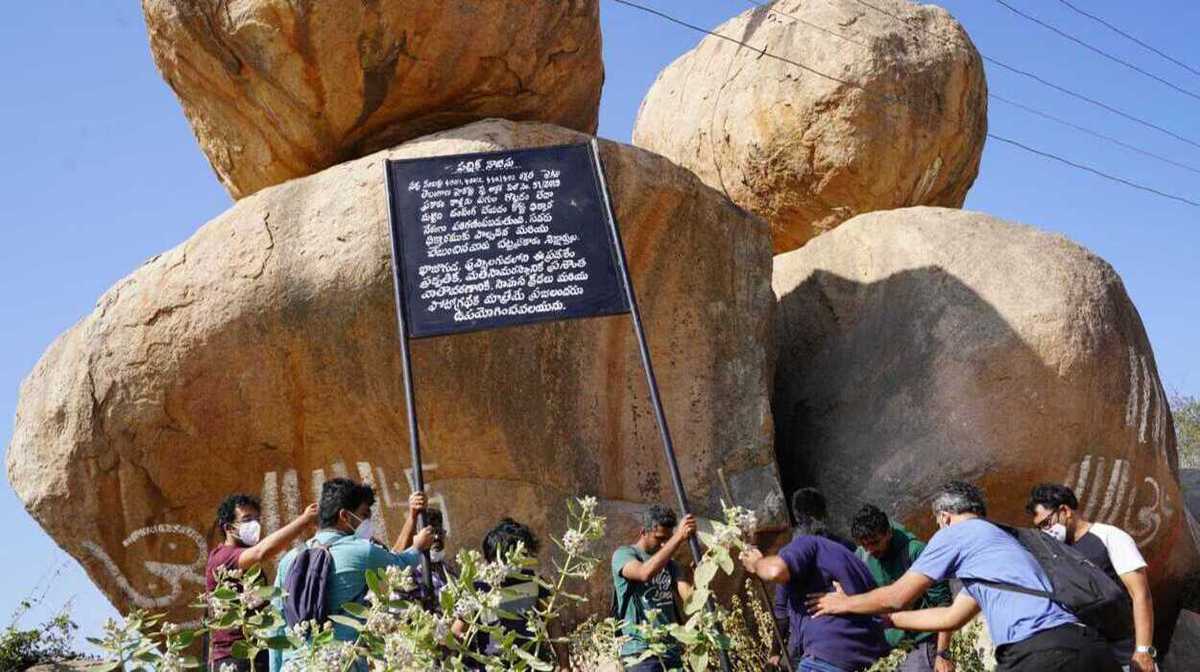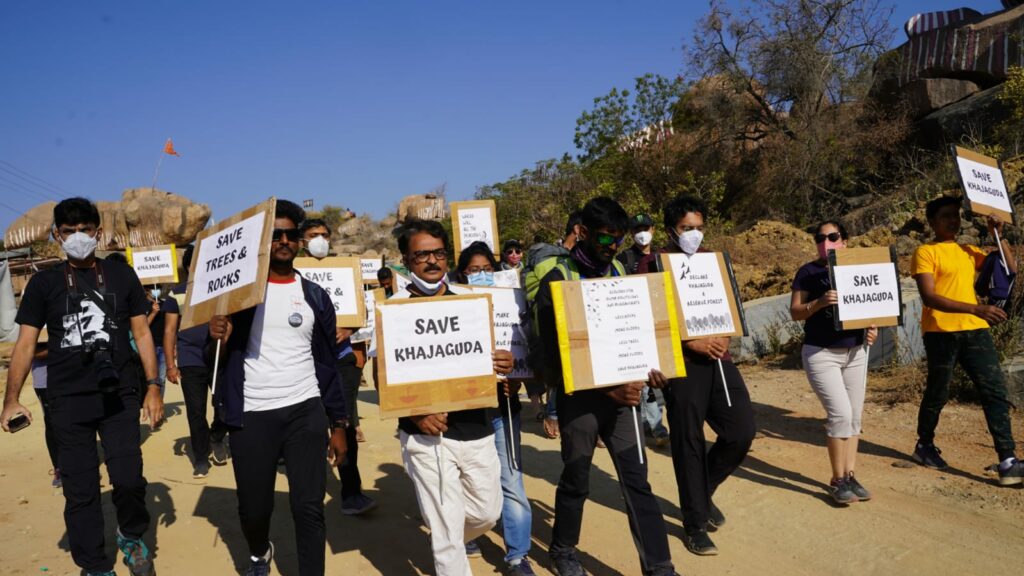
Hyderabad: The Telangana government has suspended a Village Revenue Assistant (VRA) after it was found that four persons had encroached and destroyed rocks at the historic Khajaguda rock site. Municipal Administration and Urban Development special secretary Arvind Kumar said that six security guards now be placed at the site 24/7 to protect it.
The development comes after activists and concerned citizens had protested and placed set up display boards in English and Telugu at the heritage site last Sunday citing the Telangana High Court’s order from 2019, which protects the monument. In a tweet, Arvind Kumar also said that after examining the situation an FIR was filed against four persons 4 persons for encroaching and destroying the site.
After last week’s protest, activists said that they will also soon be filing a contempt of court against the Hyderabad Metropolitan Development Authority (HMDA) and the Greater Hyderabad Municipal Corporation (GHMC). Last Sunday’s protest also reached state IT and MA&UD minister K. T. Rama Rao (KTR) who asked Kumar to look into the issue.
The boards put up by the activists read: “Survey Numbers 450/1, 450/2, 448, 452, are protected sites as per Telangana High Court stay order PIL No.51/2019. Any disturbance to any rock, hill by cutting rocks or dumping will be held as contempt of the court. The Person carrying out the activity and the instigators are punishable by law. Khajaguda is a place for nature, peaceful brotherhood of three faiths, adventure sports, tranquillity, and photography only.”
The Anantha Padmanabha Swamy temple trust (which is near the Khajaguda rocks) started the construction of a borewell in the wee hours of the night last week on February 24, resulting in more destruction at the Khajaguda heritage rock site. While the Narsingi police stopped the illegal drilling, it brings to light the fact that the heritage site’s security has been compromised.
The HMDA, which is the authority in-charge of protecting it, was caught unaware of it.

Confirming the drilling, the chairman of the temple trust, Satyanarayana said that the setting up of the bore was essential as there wasn’t water available for the temple or the gau-shaala (cow shelter) nearby. “The previous bore was damaged four or five times owing to the demolition of rocks. So we decided to install a new one about 150 metres from the temple. Without water, the cows and the temple would suffer,” he told Siasat.com. .
Last Sunday, when the activists were in the process of placing the boards at locations that were prone to destruction in the past, the temple authorities questioned them. Heated conversations followed for close to an hour. After activists explained the High Court order to them, everybody in the end agreed that the rocks should be protected and the temple authorities also took part in the protest.
What are Khajaguda Rocks?
Fakhruddin Gutta, popularly known as Khajaguda Hills, is a protected heritage site immensely loved and visited by trekkers, rock climbers, walkers, and others. However, for more than a decade, the place has been witnessing drilling and destruction for the purpose of ‘development’, which is now being met with resistance from activists and various citizen groups.
The site with rocks dating to several million years is located in Nanakramguda and is just a 20-minute drive from the Amazon Hyderabad campus and the Indian School of Business (ISB) in Gachibowli. It provides a green lung space amidst the hectic, concrete-filled IT corridor. It is also the location of the Hyderabad Climbing Championship that is gaining recognition across the country.
The rock formations at Khajaguda, dating to several million years, are unique in several ways. Several caves systems in Telangana are not formed by the movement of water, but by the gradual weathering and breaking away of granite in hillocks.
The largest of these open cave formations in the region are found at Khajaguda. Besides the unique open cave system, there are also projections at Khajaguda that are important for their geological and aesthetic value. The geological term for these projections is Castle Koppies, Kopje, or Tors, better known locally as the ‘sandwich rock.’ These, too, are the largest of their kind to be found in the region, cannot be found anywhere else.
The forest patch at Khajaguda is home to several species of plants, that just like the rock formations, are difficult to find near Hyderabad. The Nyctanthes arbor-tristis, popularly known as the parijata or the night-flowering jasmine, is found in abundance at Khajaguda (there are three national parks around Hyderabad and the Parijata cannot be found in any of these three parks).
The other important plant species at Khajaguda is the Helicteres isora, also known as the Indian Screw Tree. These trees have not been recorded by the Botanical Survey of India in any areas around Hyderabad. Khajaguda is the only place where these can be found.
Several species of these plants and trees have been lost in Khajaguda over the last few years. In 2020, over 100 trees, which include Neem, Indian Laburnum, Sitaphal, and many more. In January 2022 alone, 80 trees were lost as the soil was dumped in different places and trees were felled under the guise of a plantation drive.

